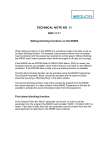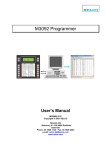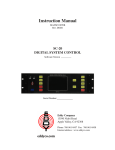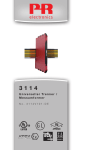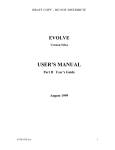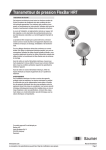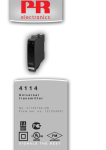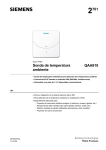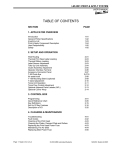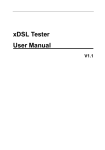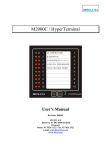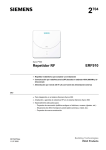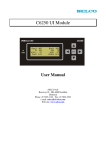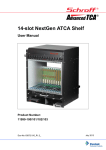Download Analog Alarm Annunciator M3000
Transcript
Analog Alarm Annunciator M3000 User’s Manual SELCO A/S Betonvej 10 – DK-4000 Roskilde Denmark Phone: 45 7026 1122 - Fax: 45 7026 2522 e-mail: [email protected] www.selco.com Analog Alarm Annunciator M3000 M3096A-31E Table of contents 1. INSTALLATION ............................................................................................................................. 5 1.1 Dimensions .............................................................................................................................. 6 2. CONNECTION .............................................................................................................................. 7 2.1 Power Supply........................................................................................................................... 8 2.2 Inputs ....................................................................................................................................... 8 2.2.1 Voltage and Current Sources ............................................................................................ 9 2.2.2 Potential Free Contacts..................................................................................................... 9 2.2.3 Mixed Sensor Types.......................................................................................................... 9 2.2.4 PT100, Thermocouples and Pressure Sensors............................................................... 10 2.3 Open Collector Outputs ......................................................................................................... 11 2.3.1 ALARM OUT ................................................................................................................... 11 2.3.2 SIREN ............................................................................................................................. 11 2.3.3 OUT1 - OUT14 ................................................................................................................ 11 3. CONFIGURATION ...................................................................................................................... 12 3.1 Physical Input......................................................................................................................... 14 3.1.1 Input Type ....................................................................................................................... 14 3.1.2 LCD Unit.......................................................................................................................... 14 3.1.3 Input Lower Reference .................................................................................................... 14 3.1.4 LCD Lower Reference..................................................................................................... 14 3.1.5 Input Upper Reference .................................................................................................... 14 3.1.6 LCD Upper Reference..................................................................................................... 15 3.1.7 Miscellaneous.................................................................................................................. 15 3.2 Logical Input........................................................................................................................... 15 3.2.1 Average Calculation ........................................................................................................ 15 3.3 Alarm...................................................................................................................................... 16 3.3.1 Input Reference............................................................................................................... 16 3.3.2 Set Point.......................................................................................................................... 16 3.3.3 LCD Description .............................................................................................................. 17 3.3.4 Delay ............................................................................................................................... 18 3.3.5 LED ................................................................................................................................. 18 3.3.6 Output.............................................................................................................................. 18 3.3.7 Flags................................................................................................................................ 18 3.3.7.1 Block ......................................................................................................................... 18 3.3.7.2 Control Mode ............................................................................................................ 19 4. OPERATION ............................................................................................................ ...................20 4.1 Keyboard Dialog .................................................................................................................... 20 4.1.1 Siren Deactivation ........................................................................................................... 20 2 SELCO A/S M3096A-31E Analog Alarm Annunciator M3000 4.1.2 LED Reset....................................................................................................................... 20 4.1.3 Output Deactivation......................................................................................................... 21 4.2 Alarm Indication ..................................................................................................................... 21 5. PROGRAMMING ........................................................................................................................ 21 5.1 Physical Input ........................................................................................................................ 22 5.1.1 Input Type ....................................................................................................................... 22 5.1.2 LCD Unit.......................................................................................................................... 22 5.1.3 Input Lower Reference.................................................................................................... 22 5.1.4 LCD Lower Reference..................................................................................................... 23 5.1.5 Input Upper Reference.................................................................................................... 23 5.1.6 LCD Upper Reference..................................................................................................... 23 5.1.7 Miscellaneous ................................................................................................................. 24 5.2 Logical Input .......................................................................................................................... 24 5.2.1 Average........................................................................................................................... 24 5.3 Alarm ..................................................................................................................................... 25 5.3.1 Input Reference............................................................................................................... 25 5.3.2 Set Point.......................................................................................................................... 25 5.3.3 LCD Description .............................................................................................................. 26 5.3.4 Delay ............................................................................................................................... 26 5.3.5 LED ................................................................................................................................. 26 5.3.6 Output ............................................................................................................................. 26 5.3.7 Flags ............................................................................................................................... 27 6. LOW-LEVEL CONFIGURATION................................................................................................. 27 6.1 General Constants................................................................................................................. 27 6.1.1 A00 - E²PROM Initialization ............................................................................................ 27 6.1.2 A01 - Function Test......................................................................................................... 27 6.1.3 A03 - Device Number...................................................................................................... 27 6.1.4 A05 - RS232 Baud Rate.................................................................................................. 28 6.1.5 A06 - RS485 Baud Rate.................................................................................................. 28 6.1.6 A07 - Remote Reset........................................................................................................ 28 6.1.7 A08 - Output Follows Input.............................................................................................. 28 6.1.8 A09 - Remote LED Test .................................................................................................. 28 6.1.9 A10 - Block...................................................................................................................... 28 6.1.10 A11 - M1000 Reset Function ........................................................................................ 28 7. SPECIFICATIONS ...................................................................................................................... 30 8. APPENDIX 1 - APPLICATION EXAMPLES................................................................................ 31 8.1 Current Transmitter 4 - 20 mA ............................................................................................... 31 8.1.1 Connection ...................................................................................................................... 31 8.1.2 Configuration................................................................................................................... 31 SELCO A/S 3 Analog Alarm Annunciator M3000 M3096A-31E 8.2 Potential Free Contacts ......................................................................................................... 32 8.2.1 Connection ...................................................................................................................... 32 8.2.2 Configuration ................................................................................................................... 32 8.3 Average Temperature Alarms (Engine Application)............................................................... 32 8.3.1 Connection ...................................................................................................................... 33 8.3.2 Configuration ................................................................................................................... 33 Important note: This document contains information on a new product. Specifications and information herein are subject to change without notice. Please advise SELCO for further details on latest developments. 4 SELCO A/S M3096A-31E 1 Analog Alarm Annunciator M3000 INSTALLATION The M3000 is designed for flush mounting. Outside dimensions are H x W x D = 144 x 144 x 70mm. A cut out with dimensions H x W = 138 x 138mm must be made in order to install the unit in the switchboard cabinet. Make sure that there is enough space in the switch board cabinet behind the unit to install the plugin connectors and the cables. An installation depth of between 75 and 90mm is recommended. The M3000 is secured to the switch board plate through the use of the 4 mounting/fixing brackets included in the package. Install the M3000 as described below. • Find a location in the switch board cabinet with enough installation depth to house the M3000 unit. Make sure that the selected location is also satisfactory from the operator’s point of view. • Keep in mind that it may be convenient to make room for the RS232 connection if you plan to do external programming from a PC in the future. • Make a cut out with the dimensions H x W = 138 x 138mm in the cabinet plate. • Remove all the plug-in connectors located at the rear side of the unit. • Make sure the rubber gasket is in place behind the unit front plate. This gasket is necessary to ensure compliance with the IP54 requirements. • Insert the unit into the cut out. • Place the 4 mounting/fixing brackets in the small rectangular cut outs located at the top and bottom plates of the unit. • Tighten the 4 mounting/fixing brackets with a screwdriver until the unit is firmly seated. Be careful not to make the connection cables too short. Extending the length of all cables with around 100mm will ease any later service task. SELCO A/S 5 Analog Alarm Annunciator M3000 1.1 M3096A-94E Dimensions 70mm 144mm 144mm 4.5mm Cut out 138 x 138mm 6 SELCO A/S M3096A-94E 2. Analog Alarm Annunciator M3000 CONNECTION The M3000 includes a number of plug-in connectors. Each of these connectors houses a number of screw terminals to which the cables are connected. The plug-in terminals can easily be attached and removed without the use of any tools. The plug-in connectors include the connection terminals for the power supply, the 24 sensor inputs and the 16 open collector outputs. The figure below shows the rear side of the M3000 unit. 8 input groups Includes 3 input terminals for analog or digital signals and 1 GND terminal for common reference RS232 Used for remote configuration with the SELCO M3092 Programmer ALARM//PROG PROG ALARM Switchto toselect select Switch alarmor or alarm programming mode programming mode RS485 Used for communication with the SELCO H0300 Event Logger or another bus system 16 open collector outputs Power supply and dimming LCD contrast The M3000 includes 8 groups of input terminals. Each group is physically represented by a plug-in connector that holds 3 input terminals, “IN1”, “IN2” and “IN3”, and one common reference terminal “GND”. Be sure not to confuse the physical inputs with the logical inputs “INA”, “INB” and “INC”. The logical inputs has no related input terminals, they are imaginary inputs intended for average calculation based upon other inputs. The logical inputs are described later in this manual. Alarm annunciation is done through 48 programmable alarms. Each alarm can be programmed to monitor a physical or logical input. Alarm annunciation takes place when the input signal exceeds the set point of the alarm. An alarm is able to control one LED and one open collector output. Control of external equipment is possible through the use of 16 open collector outputs. 14 of these outputs, “OUT1” to “OUT14”, are user programmable for alarm dependent control. The “SIREN” output is mainly intended for the control of an acoustic warning device. An active “AL.OUT” signal indicates that an alarm condition exists on the unit. The M3000 includes two interface standards for serial data communication. The RS232 interface is intended for point to point data communication between the M3000 and another device, e.g. a PC. RS485 is intended for long distance bus communication between multiple M3000 units. SELCO A/S 7 Analog Alarm Annunciator M3000 M3096A-94E The small switch on the left side of the rear panel is used to change between program mode and alarm mode. In program mode the functions of the unit can be programmed. Alarm mode is the normal alarm mode. The potentiometer at the bottom behind the front plate provides contrast adjustment for the liquid crystal display (LCD). 2.1 Power Supply The M3000 requires a supply of +24V DC. The supply wires must be connected between terminal 120 (+24V DC) and terminal 121 (GND). The supply voltage is required to be within the range of +18V DC to +30V DC, this voltage range corresponds to ±30% of the nominal supply voltage. The current consumption from the +24V DC supply is less than 400mA. The power supply plug-in connector of the M3000 includes 3 terminals, one for +24V DC, one GND reference and one terminal DIM for dimming of the LED’s on the front panel of the unit. For dimming purpose a potentiometer of 100k is connected between the terminal 122 (DIM) and terminal 121 (GND). The connection of the +24V DC supply and the potentiometer for dimming is shown below. DIM 100K Important note: The power supply used for the M3000 and its interface components should be operative and stable under all conditions. The M3000 is in most cases required to be operative at all times - even under a possible “black out” condition. 2.2 Inputs The M3000 includes a total of 24 inputs. Each of these inputs will accept the connection of one sensor. The sensor can be a PT100 or a thermocouple supplying a current or voltage signal through the use of a standard transmitter. It is also possible to connect a potential free contact to an input. The sensors need not be for temperature, it is in fact possible to connect any sensor that is, in some way, able to provide a DC voltage or current signal. The input types are 10V DC, 24V DC and 0-20mA. Please note that the voltage on an input terminal is measured according to the common reference of the unit (GND). The supply GND terminal and the group plug-in GND terminals are connected together. 8 SELCO A/S M3096A-94E Analog Alarm Annunciator M3000 2.2.1 Voltage and Current Sources Below are two examples. These examples show the two most common input configurations. The figure to the left shows the connection of 3 voltage sources supplying a voltage within the range of 10V DC. The figure to the right shows how to connect 3 current sources. 2.2.2 Potential Free Contacts The M3000 is capable of annunciating digital alarms. In this case the sensor will be some kind of potential free contact. The potential free contact will actually control the connection of a voltage source The figure below shows 3 potential free contacts on the same input plug-in connector. The reference of the contacts is +24V DC. 2.2.3 Mixed Sensor Types The previous examples of how to connect different sensors involved a whole input plug-in connector (3 inputs) at one time. However it is also possible to mix the sensor types within an input plug-in connector. Please refer to the example below. The example above shows 3 different sensors connected to the same input plug-in connector. Input terminal “IN1” is connected to a potential free contact to +24V DC. Input terminal “IN2” is connected to a current source. SELCO A/S 9 Analog Alarm Annunciator M3000 M3096A-94E Input terminal “IN3” is connected directly to a voltage source providing a voltage difference between “IN3” and “GND”. 2.2.4 PT100, Thermocouples and Pressure Sensors Note that there is a wide range of transmitters on the market that provide an output signal of 4 to 20 mA. A transmitter of this type is actually a current source and should be connected as such. An example describing the connection of a Kamstrup-Metro Flex Temp transmitter is shown below. The connection of other 4-20 mA transmitters is similar to this example. The transmitter shown above works like a current gate. It releases only 4mA at 0°C and 20mA at 100°C. Two Danish companies that supplies 4-20mA transmitters: • Kamstrup A/S • PR Electronics Jacob Knudsens vej 12, DK-8230 Åbyhøj Phone: +45 89 31 76 11 Fax: +45 86 25 65 77 Lerbakken 10, DK-8410 Rønde Phone: +45 86 37 26 77 Fax: +45 86 37 30 85 The SELCO PT100 6 Way Transmitter M1500 provides a cost-effective solution and includes 6 current transmitters in one box to be connected to PT 100 resistors. The following diagram shows the connections of the M1500. 4-20mA OUT 6 OUT 5 PT100 5. GND 4-20mA OUT 4 + GND 4-20mA GND PT100 4. PT100 6. 17 18 19 20 21 22 23 24 25 26 27 28 29 30 31 32 M1500 10 10 11 12 13 14 15 16 PT100 3. OUT 3 PT100 2. 9 + GND 8 4-20mA 7 OUT 2 6 GND 5 4-20mA PT100 1. 4 OUT 1 3 GND 2 4-20mA 1 SELCO A/S Analog Alarm Annunciator M3000 M3096A-94E The example below shows connections to one input group of M3000. For more details see separate data sheet M1595. 17 18 19 20 21 22 23 24 25 26 27 28 29 30 31 32 M1500 6 7 8 PT100 2. 9 10 11 12 13 14 15 16 PT100 3. OUT 3 5 OUT 2 PT100 1. 4 GND 3 OUT 1 2 GND 1 + - 2.3 Open Collector Outputs The M3000 includes a total of 16 open collector outputs. Each output is capable of driving an external LED or a relay. One output will indicate that an alarm is present on the M3000 and another output is mainly intended for siren control. The remaining 14 open collector outputs can be used for group alarms or alarm dependent control of external equipment. Open collector outputs are digital outputs that are either on or off. 2.3.1 AL.OUT The “AL.OUT” (115) output is an open collector output. Like all other open collector outputs, this output is at GND level when active and at +24V DC level when inactive. The “AL.OUT” output is active as long as one or more alarms are present on the M3000. If alarms are already present on the unit when a new alarm is annunciated, the output is briefly deactivated for about 500 ms to indicate the annunciation of a new alarm. 2.3.2 SIREN The terminal marked “SIREN” (116) is an open collector output intended for controlling an acoustic warning device. This output is activated to annunciate a new alarm. The output is deactivated by the first press of the “C” key, located on the M3000 front plate. Output is at GND level when active, and at +24V DC level when inactive. The figure below shows how to connect a relay for control of the siren. The relay is shown in its deenergized state. 2.3.3 OUT1 - OUT14 The M3000 includes 14 open collector outputs intended for general use. These outputs can be programmed to activate upon annunciation of any one of the 48 alarms that the M3000 includes. SELCO A/S 11 Analog Alarm Annunciator M3000 M3096A-94E An output is activated together with the annunciation of the controlling alarm. The output will stay active until the operator acknowledges the alarm from the M3000 keyboard. Second press of the “C” key will deactivate the output. An output will operate according to an “OR” function if controlled by more than one alarm. This means that an output will be active if either one of the controlling alarms is active. The figure below gives an example of how to indicate the state of output 3 and 5 on two remote LED’s. Normally the outputs are intended for driving relays. The open collector output “AL.OUT” can be used to signal the appearance of multiple alarms controlling the same output. An open collector output will not drive anything. It works only as an electronic contact to GND. 3. CONFIGURATION The configuration of the M3000 unit consists of a number of parameters that describe the set-up of the 24 physical inputs, the 24 logical inputs and the 48 alarms. The configuration of a physical or logical input includes parameters that describe the expected signal type and range, the unit of measurement and the relationship between the input signal, in volt or ampere, and the measurement in °C, kW or whatever unit that is to be measured. On top of this the logical inputs have one additional parameter with 12 cells that holds references to the inputs that takes part in the average calculation performed by the logical input. The configuration of an alarm includes parameters that describe the reference of the input, to which the alarm has been assigned, a set point (fixed or dynamic) that defines the level of alarm annunciation, a delay and references to the LED and open collector output that are to be activated in order to annunciate the alarm. A 10 character user defined text string holds the description of the alarm. The parameters of the configuration must be adjusted before the unit can be put into operation. Note that it is only necessary to adjust the parameters of the active inputs and alarms. Inputs having no connection to a sensor should be disabled by setting the input type parameter to “Off”. Alarms that are not in use should have their input reference parameter set to “Off” as well. 12 SELCO A/S M3096A-94E Analog Alarm Annunciator M3000 The configuration parameters are stored inside a non-volatile memory circuit (an E²PROM) located inside the unit. The non-volatile memory is kept intact - even if power supply is disconnected for a long period. It is possible to program the configuration of the M3000 in two different ways. The first way is to enter the configuration parameters directly from the front plate keyboard of the M3000. This method is also referred to as “LCD programming”. During LCD programming, the configuration parameters are displayed in the liquid crystal display while the operator is allowed to alter the state of each parameter. The other way is to program the M3000 through the unit RS232 interface. Important note: The switch located on the rear left side of the M3000 must be in program mode (“PROG”) to allow programming from either the keyboard and/or the RS232 interface. The procedure of LCD programming is much like the programming procedures that you might already know from VCRs, televisions and other microprocessor based products. The operator is able to move around between the configuration parameters through the use of a selection key. Each parameter of the configuration can be modified by toggling, or by simply entering the new value from the numeric keys of the unit keyboard. RS232 programming involves the use of a standard PC with Windows 95, Windows 98, Windows 2000 or Windows XP operation system. SELCO has developed a user-friendly application called the M3092 Programmer. This application enables the operator to program the M3000 through use of the built-in RS232 interface. The parameters are entered in very much the same way as in a Microsoft Excel Spreadsheet. This method of programming is ideal for setting up a M3000 from scratch. The SELCO M3092 Programmer is validating all data that is entered, and all the configuration parameters can be modified in the program. The configuration can be stored on disk and it can be printed out for documentation. The data can also be exported to Excel. Sensors are connected to the M3000 unit through the input terminals included in the 8 plug-in connectors located at the rear side of the unit. Each of the 8 input plug-in connectors is referred to as a “group”. Each group includes 3 input terminals named “IN1”, “IN2” and “IN3”, and one common reference terminal named “GND”. As mentioned earlier, a group refers directly to the 3 inputs located in an input plug-in connector. Note however that each of the 3 physical inputs located in a group can be used with different types of sensors. Seen from a configuration point of view, each group also includes 3 logical inputs and 6 alarms. The logical inputs are configured like the physical inputs but they have no related input terminal. The logical inputs are used to do average calculations from up to 12 physical or logical inputs. Each of the 6 alarms refers directly to a physical or logical input. The input does not have to be within the same group as the alarm. It is possible to assign all 48 alarms to the same input. Normally one would assign between one and 4 alarms to one input, two alarms would give every one of the 24 physical inputs one low and one high level alarm. SELCO A/S 13 Analog Alarm Annunciator M3000 M3096A-94E 3.1 Physical Input The parameters included in the configuration of a physical input are described below. The table shows the parameters of the 3 physical inputs encapsulated in one group. Inp: Inp:1 Inp:2 Inp:3 InpTp: 20 mA 10 V 24 V LCDU: ˚C kW V DC InpLo: 4 0 0 LCDLo: 0 0 0 InpUp: 20 10 24 LCDUp: 600 25 24 Misc: 0 0 0 3.1.1 Input Type The “InpTp” parameter defines both the type of input signal and the expected maximum range of that signal. The range defined by the “InpTp” parameter must cover the expected range of the signal provided by the sensor connected to the input. Example: “InpTp” should be set to 20 mA in order to accept the connection of a 4-20 mA transmitter. Setting this parameter to “Off” will completely disable the physical input. 3.1.2 LCD Unit This parameter defines the unit of measurement. The parameter holds a combination of 4 characters. The selection of these 4 characters will not affect the operation of the M3000 in any way, the contents of the “LCDU” parameter is only used for indication in the display. Example, likely LCD units: “˚C”, “˚F”, “Volt” and “kW”. 3.1.3 Input Lower Reference Defines the lower reference value of the input signal. The “InpLo” parameter is used together with the “LCDLo” parameter to form the relation between the actual input signal, in voltage or current, and the measured value expressed in the unit defined by the LCD unit parameter. Example, consider the following parameter set-up: InpTp: 20 mA LCDU: ˚C InpLo: 4 LCDLo: 0 This will tell the M3000 that a current signal between 0 and 20 mA is expected at the input terminal and that the desired unit of measurement is degrees Celsius, indicated by the “˚C” in the LCD unit parameter. The parameters “InpLo” and “LCDLo” indicate that 4 mA on the input should be translated to 0 C in the LCD. 3.1.4 LCD Lower Reference This parameter holds the low reference point of the measured value and defines a low reference relation together with the “InpLo” parameter. Please refer to the prior explanation of the “InpLo” parameter for further details. 3.1.5 Input Upper Reference The “InpUp” parameter defines the upper reference point of the input signal. As with the lower reference, the upper reference is used to form a relation between the actual input signal, in voltage or current, and the measured value expressed in the unit defined by the LCD unit parameter. Example, consider the following parameter set-up: 14 SELCO A/S Analog Alarm Annunciator M3000 M3096A-94E InpTp: 20 mA LCDU: ˚C InpUp: 20 LCDUp: 600 The above configuration will inform the M3000 that a current signal is expected on the input. The combination of the “InpUp” and “LCDUp” parameters forms the relation, 20 mA measured on the input should bring the M3000 to show 600˚C in the LCD. Please refer to the description of the “InpLo” parameters as well. 3.1.6 LCD Upper Reference Defines the upper reference point of the measured value. This parameter works together with the “InpUp” parameter to define a relation. Please refer to the above description on the other reference points. 3.1.7 Miscellaneous This parameter is intended for future use. At present the value has no affect on the operation of the unit. 3.2 Logical Input The parameters included in the configuration of a logical input are described below. The table shows the parameters of the 3 logical inputs encapsulated in one group. Logical inputs are used and referred to like physical inputs, but a logical input has no related input terminal. Logical inputs are used to represent the average of the measurements collected from up to 12 other physical or logical inputs. Inp: Inp:A Inp:B Inp:C InpTp: 20 mA 10 V 24 V LCDU: C kW V DC InpLo: 4 0 0 LCDLo: 0 0 0 InpUp: 20 10 24 LCDUp: 600 25 24 Misc: 0 0 0 Avrg: 01 11 02 21 07 Off Please turn to the pervious description of the physical input parameters for an explanation of the following parameters also included in the configuration of each logical input: InpTp, LCDU, InpLo, LCDLo, InpUp, LCDUp and Misc These parameters should always have the exact same value as the inputs included in the average calculation performed by the logical input. 3.2.1 Average Calculation The very reason for the existence of the logical inputs is the need for average calculation. One logical input will perform an imaginary measurement that will correspond to the average of the measurements from up to 12 physical or logical inputs. Each of 12 input references can point to any physical or logical input. Input references that are not required must be set to “Off” using the “C” key. In the example above “01 11” means that reference # 01 points to group 1 input 1 (11). “02 21” means that reference # 02 points to group 2 input 1 (21). “07 Off” means that reference # 07 are not used and therefore set to “Off”. SELCO A/S 15 Analog Alarm Annunciator M3000 M3096A-94E Important note: It is very important that all inputs referred to by the average parameter have compliant parameter values assigned. The logical input itself must also comply with this rule. Failing to do so may impose a significant error on result returned by the average calculation. The average calculation of a logical input can be described by the formula below: N IN n Average n 1 N The variable “Average” represents the measurement on the logical input. “N” is the number of physical and logical inputs that takes part in the average calculation (max. 12). “INn“is the measurement of each physical or logical input. Note that the measurement of the logical input equals the sum of all input measurement divided by the number of measurements. Example, consider one diesel engine with 12 cylinders. The temperature measurement on each cylinder could be picked up through 12 physical inputs. A logical input might then be used to “measure” the average temperature on all 12 cylinders. It is also possible to use the average temperature as a dynamic set point for one or more alarms. 3.3 Alarm The parameters included in the configuration of an alarm are described below. The table shows the parameters of the 6 alarms encapsulated in a group. Alr: InpRf: Set: Text: Delay: Alr:1 Alr:2 Alr:3 Alr:4 Alr:5 Alr:6 11 11 21 22 31 32 <0 > 100 < 10 > 10 > 1000 < 1A 30 Freezing Boiling Low press High press Overload Average 100 x 10 ms 100 x 10 ms 30 x 10 ms 30 x 10 ms 10 x 1 min 15 x 1 s LE D: L01 L01 L02 L03 L14 L15 Outp: Flags: O01 O01 O02 O02 Off Off 00000000 00000000 00000000 00000000 00000000 00000000 3.3.1 Input Reference The “InpRf” parameter holds the reference to the input to which the alarm has been assigned. The “InpRf” parameter includes two decimals, the first decimal holds the number of the group, and the last decimal holds the number of the input. Example: An input reference of “31” indicates a reference to input 1 (IN1) of group 3. Set this parameter to “Off” to disable the alarm. 3.3.2 Set Point The “Set” parameter defines the set point of the alarm. The set point describes the level and area of alarm condition relative to the measured value. The set point is always expressed in the unit indicated by the LCD unit parameter of the surveyed input. 16 SELCO A/S Analog Alarm Annunciator M3000 M3096A-94E The set point parameter consists of an operator, a sign and a value. In some cases the sign is replaced by a logical input reference. The set point value can be a fixed value (e.g. a fixed temperature) or a dynamic reference with a plus/minus offset. The average calculated by a logical input can be used as a dynamic set point. The fixed valued used together with a dynamic reference indicates a plus/minus offset from the measurement of the dynamic reference. In the example above for alarm 6 “1A” is the dynamic reference and “30” is the plus/minus offset. The operator “<” will be disregarded in this case. The function of a fixed set point is quite simple. The alarm is annunciated when the measurement of the related input passes above or below the set point. Input > fixed set point => Alarm or Input < fixed set point => Alarm The matter gets a little bit more complicated with the dynamic set point. The figure below shows the relation between the dynamic set point (the logical input) and the plus/minus offset. Dynamic Set Point Level Alarm Input ref. Upper offset Set point Lower offset Time The middle line in the above figure describes the dynamic set point. Note that the level of the set point changes over time. It simply follows the measurement of the related logical input. The two lines above and beneath the dynamic set point are the offsets. The offsets define the actual alarm levels in relation to the dynamic set point. Alarm condition exists if the measurement of the related input passes above the upper offset or below the lower offset. The measurement of the related input is indicated by the dotted line. Note that the related input is not included in the average, as this would influence the average value in an unwanted manner for such applications. 3.3.3 LCD Description This parameter holds a 10 character text that is shown on the LCD together with the actual measurement and the alarm set point. The alarm text is only used for indication and the choice of characters will not affect the operation of the M3000 in any way. SELCO A/S 17 Analog Alarm Annunciator M3000 M3096A-94E 3.3.4 Delay The alarm delay parameter can be used to prevent small spikes in the related input signal from activating the alarm. Long alarm delays are useful for preventing frequent annunciation of less essential alarms. An alarm condition will exist when the input signal has exceeded the alarm set point for a time period longer than the time specified by the delay parameters. The alarm delay consists of a time value and a multiplication factor. Important note: It is very important that the smallest possible factor is selected to form the delay. The factor will represent the resolution of the timer that operates the delay. A 10 seconds delay should be made from a time value of 100 and a multiplication factor of 100 ms. Selecting a time value of 1 and a multiplication factor of 10 seconds would result in a less accurate delay function. The time value should normally be between 10 and 100. When using the M3092 M-Programmer it is not necessary to worry about time value and multiplication factor. The delay should just be entered in seconds and the program will take care of the rest. The minimum delay is 300 ms. An alarm will be annunciated once the level defined by the alarm set point has been continuously ex- or subceeded for the time defined by the alarm delay. 3.3.5 LED The “LED” parameter holds a reference to the LED that is to be activated upon alarm condition. Any of the 24 LED’s located on the unit front plate can be activated to visual annunciation of an alarm, and one or more alarms can use the same LED for indication. Setting this parameter to “Off” will disable LED indication for the alarm. 3.3.6 Output Setting the “Outp” parameter will enable to unit to activate one of the 14 open collector outputs upon alarm condition. The output can be used to control external lamps or relays. The “Outp” parameter should be set to “Off” when no external control is required. 3.3.7 Flags The 8 bits of the “Flags” parameter control specific alarm related functions. The 8 bits work like 8 programming contacts. A “contact” is on when the bit is set to one and the “contact” if off when a bit is set to zero. The bits of the “Flags” parameter are numbered from 0 to 7; number 0 is the bit furthest to the right. 3.3.7.1 Block Bit number 7, the first bit from the left, represents the status of the alarm block function. The related alarm will be blocked by the block control input when this bit is set to “1”. Input terminal one of group 8 can be configured to operate as the block control input. Please refer to the description of the low level configuration. Example: Most pressure alarms from an engine must be blocked until the engine has reached normal revolutions. Without blocking the M3000 will report pressure alarm while the engine is off duty (not running). 18 SELCO A/S M3096A-94E Analog Alarm Annunciator M3000 3.3.7.2 Control Mode Bit number 6, the second bit from the left, represents the status of the alarm control mode. The alarm will be in control mode when bit number 6 is set to “1”. Control mode is intended for level dependent control of external equipment. External equipment can be connected to the 14 open collector outputs of the M3000. In normal alarm mode the open collector output (if any) of the alarm will be activated on alarm condition, the LED (if any) of the alarm will be flashing and the two common collector outputs “AL.OUT” and “SIREN” will be activated. The alarms will stay active until the operator acknowledges the alarms from the M3000 keyboard or until the remote reset function is used. In control mode the open collector outputs are used for level dependent control of external equipment. The outputs are not considered as alarm outputs, only as control outputs. In control mode no reset is needed to disable the LED and the open collector control output, when the condition for the control signal no longer exists. The two common open collector outputs “AL.OUT” and “SIREN” are not activated in control mode. The LEDs controlled by “alarms” in control mode will not flash, they will have steady light for “alarm” condition (exceeded set point), and no light for normal condition. Control mode can be used for switching on and off heating, via one of the open collector outputs, depending on the actual temperature. The heating will be switched on, once the temperature drops below a pre-set level, and it will be switched off again when the temperature is back at the pre-set level. A delay on the “alarm” can be used as a kind of hysteresis in order to prevent frequent toggling between heating on and off. 3.3.7.3 Hysteresis Mode This section describes the hysteresis function of the M3000. This function is available in the M3000, if it has an EPROM date of 040101 (4 January 2001) or younger. The hysteresis function is typically used for “alarms” in control mode (see previous section) to switch on and off external equipment at a pre-set level with an adjustable hysteresis. The hysteresis for an “alarm” is enabled by setting bit number 5 (third bit from the left) of the “Flags” parameter for the “alarm” to 1. Setting it to 0 will switch off the hysteresis mode Example: We want to switch on heating when temperature drops below 57°C and switch it off again when the temperature is above 63°C. That means we want to switch on and off at 60°C with a hysteresis of ±3°C. The actual hysteresis should be entered in percent as a General Parameter using the SELCO M3092 M-Programmer or from the keyboard as described in the description of the low level configuration. In our case where we use a 4-20mA, 0-100°C transmitter at the input, 3°C is equal 0.6mA. The 0.6mA is equal 2.4% of the full-scale level 20mA. SELCO A/S 19 Analog Alarm Annunciator M3000 M3096A-94E Hysteresis mode is enabled for all “alarms” where this hysteresis is wanted by setting bit number 5 of the “Flags” parameter to 1. “Alarms” set into hysteresis mode will now have a hysteresis of the entered value (± 2.4% of full-scale level in the above example). 4. OPERATION The M3000 unit is operated from the front plate keyboard. Some of the keys included in the keyboard layout have different meaning depending on the operational state of the unit. Generally the unit can be in one of two different operational states; alarm surveillance mode or programming mode. Please make sure that the correct mode is selected on the switch at the rear side of the unit. 4.1 Keyboard Dialog The figure below shows the various functions available through use of the unit keyboard. Mode Selector Used to switch between modes. During alarm indication mode this key toggles the indication between normal alarm description and physical voltage or current measurements. Master reset, LCD test & parameter selector Stops the siren and performs master reset during normal alarm mode. Used for lamp test after pressing the “M” key in normal alarm indication mode. Used for parameter selection during programming mode. Alarm selector & parameter toggle While in alarm indication mode these two keys are used to select an alarm for indication in the LCD. The arrow keys will toggle the value of any multiple choice parameter during programming mode. Numeric keys While in normal alarm indication mode the keys are used to toggle between the alarms represented by the nearby LEDs for indication in the LCD. Used for entering numeric data into value parameters during programming mode. Description covers the keys to the right as well. Backspace Acts as a backspace key while programming mode is active. Operator selector While in programming mode the key will toggle between sign/operator and value while editing numeric data. 4.1.1 Siren Deactivation The siren is activated together with every new alarm annunciated on the M3000. Alarms not controlling a LED or an open collector output are only indicated on the LCD, these alarms will also cause the siren output to energize. The siren is stopped by the first press on the “C” key of the M3000 keyboard. 4.1.2 LED Reset Each of the 48 alarms of the M3000 can be programmed to control one of the 24 LEDs located on the front plate. A LED will start flashing once the controlling alarm is annunciated. A flashing LED indicates a new alarm that needs acknowledgment. First press on the “C” key will stop the siren, second press will acknowledge the LED and change the flashing to steady light, and the third press will turn off the LED providing the alarm set point is 20 SELCO A/S M3096A-94E Analog Alarm Annunciator M3000 no longer exceeded. Note that the second press will also disable any open collector output controlled by the alarm. 4.1.3 Output Deactivation Each of the 48 alarms of the M3000 can be programmed to control one of the 14 open collector outputs located in the two 8 pole plug-in connectors at the rear side of the unit. The output controlled by an alarm is deactivated at the second press of the “C” key. 4.2 Alarm Indication The operator is able to switch to alarm indication mode by setting the switch “ALARM / PROG” on the rear of the unit to “ALARM” and then pressing the “M” key of the keyboard until an “A” is visible in the top left corner of the LCD. The “M” key can be used to toggle between normal alarm indication mode and a mode where physical voltage or current measurements are indicated in the LCD. When in alarm indication mode, the LCD will show the actual measurement on the sensor connected to the input referred to by the indicated alarm. The alarm set point and text description is indicated as well. The M3000 will automatically display the last incoming alarm in the LCD, but the operator is also able to select a specific alarm for indication by pressing the up/down arrow keys of the M3000 keyboard until the alarm appears in the LCD. Alternatively the numeric keys will indicate alarms associated by the 2 nearby LED's. Pressing the numeric keys will cause the indication on the LCD to toggle between these two alarms. However the indicated alarm will again change once another alarm is activated. Alarm annunciation by the LED’s and open collector outputs is always active for all alarms although only one alarm is indicated in the LCD. 5. PROGRAMMING The unit must be put into programming mode before the configuration of the 24 physical inputs, the 24 logical inputs and the 48 alarms can be altered. Programming mode is enabled by setting the switch “ALARM / PROG” on the rear of the unit to “PROG” and then pressing the “M” key of the keyboard until the text “Prg” is made visible in the top left corner of the LCD. Note that in programming mode all LED’s on the front of the unit will be on in order to indicate programming mode. This is done in order to prevent forgetting to set the unit back in alarm mode after programming the unit. Normally programming should be done through the RS232 interface using the configuration software M3092 M-programmer, which is a user-friendly software package, where the parameters SELCO A/S 21 Analog Alarm Annunciator M3000 M3096A-94E are entered very much like in a spreadsheet, such as e.g. Microsoft Excel. However, it is also possible to enter the parameters from the front panel keyboard as described in the following. Important note: Altered configuration parameters are active only a few seconds after being changed in the configuration. No enter or return key must be pressed to acknowledge new adjustments to the configuration. Please wait a few seconds after entering the last parameters before setting the unit back into alarm mode. This will make sure that the units program is updated. 5.1 Physical Input The M3000 includes a total of 24 physical inputs located in 8 groups. Each group holds 3 physical inputs and the configuration of these physical inputs will affect the function of the related hardware input terminals encapsulated by the plug-in connector at the rear side of the unit. To select the group press the “C” key a number of times to move the cursor to the number located at the right of the text “Gr:”. Then toggle the group number with the up/down arrow keys until the desired group reference is shown. The physical input is selected in the exact same way as the group. Press the “C” key to move the cursor to the right of the text “Inp:”. Then use the up/down arrow keys to toggle the physical input reference. 5.1.1 Input Type The first parameter of the physical input configuration is the input type indicated in the LCD as “InpTp”. Press the “C” key to move the cursor to the bottom left corner of the LCD, then toggle the parameters with the up/down arrow keys until the text “InpTp” is shown. Prg Gr:1 Inp:1 InpTp 20mA Press the “C” key once more to enter the parameter selection field. Select the desired input type from the rolling list with the up/down arrow keys. 5.1.2 LCD Unit The second parameter of the physical input configuration is the LCD unit parameter. Press the “C” key a couple of times until the cursor is located at the bottom left corner of the LCD. Press the “C” key once more to enter the text field. Prg Gr:1 LCDU ???? Inp:1 The LCD unit is made up from a combination of 4 characters. Once in the text field the “←“ key will select the character to edit. The selected character is toggled with the up/down arrow keys. 5.1.3 Input Lower Reference The third parameter is the lower input reference. The parameter is first selected by pressing the “C” key a number of times until the cursor is based in the lower left corner of the LCD. 22 SELCO A/S M3096A-94E Analog Alarm Annunciator M3000 Prg Gr:1 InpLo + Inp:1 0.000 The next activation of the “C” key will bring the cursor into the parameter field. The “←“ key is then used for switching between the operator and the value part of the parameter. Pressing the up/down arrow keys while the cursor is on the operator will toggle the sign between plus and minus. When the cursor is in the value field the up/down arrow keys will shift the position of the decimal point. The actual value is entered through use of the numeric keys of the keyboard. Please note that although the value field can hold any number between -65535 and 65535, it is important to keep in mind that the limits of this field are determined by the range of the selected input type. The value is set to zero by pressing the “9” key a couple of times to overflow the field. 5.1.4 LCD Lower Reference Next parameter is the lower LCD reference. Press the “C” key a couple of times to move the cursor to the bottom left position of the LCD. Then press the “C” key once more to move into the parameter field. Prg Gr:1 LCDLo + Inp:1 0.000 The programming of the “LCDLo” parameter is done exactly like described for the “InpLo” parameter. Toggle the parameter operator and decimal position with the up/down arrow keys, and switch between the operator and the parameter value with the “←“ key. 5.1.5 Input Upper Reference The upper input reference is selected by first pressing the “C” key a couple of times to move the cursor to the bottom left position of the LCD. Then press the “C” key once more to move into the parameter field. Prg Gr:1 InpUp + Inp:1 0.000 The programming of the “InpUp” parameter is done exactly like described for the “InpLo” parameter. Toggle the parameter operator and decimal position with the up/down arrow keys, and switch between the operator and the parameter value with the “←“ key. 5.1.6 LCD Upper Reference The “LCDUp” is the last of the 4 reference parameters that describes the translation between input signal and measured value. Go to the LCD upper reference parameter by pressing the “C” key until the cursor is placed in the bottom left corner of the unit. Prg Gr:1 LCDUp + SELCO A/S Inp:1 0.000 23 Analog Alarm Annunciator M3000 M3096A-94E Turn to the description of the “InpLo” parameter programming. The “LCDUp” parameter is programmed in the same way. 5.1.7 Miscellaneous This parameter has been included in the input configuration to make room for extra configuration data that might be necessary in future versions of the M3000. Prg Gr:1 Misc + Inp:1 0.000 The miscellaneous parameter is designed to contain a numeric between -65535 and 65535. The parameter is selected and altered like the 4 input reference parameters. Move the cursor to the bottom left corner of the LCD with the “C” key, toggle the parameter selection with the up/down arrow keys, and switch between the operator and the parameter value with the “←“ key. 5.2 Logical Input The M3000 includes a total of 24 logical inputs located in 8 groups. Each group holds 3 logical inputs. The logical inputs are used for average calculation based upon the measurements of up to 12 physical or logical inputs. To select the group press the “C” key a number of times to move the cursor to the number located at the right of the text “Gr:”. Then toggle the group number with the up/down arrow keys until the desired group reference is shown. The logical input is selected in the exact same way as the group. Press the “C” key to move the cursor to the right of the text “Inp:”. Then use the up/down arrow keys to toggle the logical input reference. The logical inputs shares a number of parameter types with the physical inputs. These parameter types are, the input type, the LCD unit, the lower and upper reference parameters and the miscellaneous parameter. However the logical input has one additional parameter, the average parameter. The average parameter holds the references to the inputs that take part in the average calculation. Please turn to the programming description for the physical input to get the explanation for the shared parameter types, but keep in mind that the logical inputs are named “A”, “B” and “C” instead of “1”, “2” and “3”. 5.2.1 Average The last and most essential parameter of the logical input configuration is the average parameter. Move to the parameter name by pressing the “C” key a number of times. Then press the “C” key once more to enter the parameter field. 24 SELCO A/S M3096A-94E Analog Alarm Annunciator M3000 Prg Gr:1 Inp:1 Avrg: 01 11 The “←” key is used to select between the 12 references that is accepted by each logical input. Each of the 12 input references can point to any physical or logical input. Use the “C” key to toggle the input selection for the reference indicated in the LCD. Input references that are not required must be set to “Off” using the “C” key. 5.3 Alarm The M3000 unit includes a total of 48 alarms located in 8 groups. Each group includes 6 alarms and any one of these alarms can be programmed for level surveillance of any one of the 24 physical or logical inputs. Like the inputs, the alarms are organized in groups, however note that an alarm of one group can be used to survey the level of an input located in another group. To select the group move the cursor under the number located to the right of the text “Gr:” by pressing the “C” key a couple of times, then toggle the group number with the up/down arrow keys until the desired group is indicated. An alarm is selected in the same way as the group. Move the cursor to the right of the text “Alr:” by pressing the “C” key, then change the alarm reference with the up/down arrow keys. 5.3.1 Input Reference The parameter describing the input reference is called “InpRf” in the LCD. The LCD will look like shown below when the input reference parameter has been selected. Prg Gr:1 InpRf 11 Alr:1 The reference is selected with the up/down arrow keys once the cursor has been moved beneath the reference with a press on the “C” key. 5.3.2 Set Point The set point parameter is by far the most essential parameters of the alarm configuration. Move the cursor to the bottom left corner of the LCD and press the “C” key until the text “Setp” appears above the cursor. Prg Gr:1 Set: > + Alr:1 0.000 By pressing the “C” key once more the cursor will be situated under the set point operator. The set point operator is changed with the up/down arrow keys. The “←“ key will move the cursor to the other two parts of the parameter. Apart from the operator the set point has a sign and a value. The sign is omitted when the set point is represented by a dynamic reference (logical input). The sign is selected with the up/down arrow keys. The value is SELCO A/S 25 Analog Alarm Annunciator M3000 M3096A-94E entered using the numeric keys. The up/down arrow keys will alter the decimal position of the value while the cursor is located under the value. The LCD snapshot below shows a set point programming session involving a dynamic level. Prg Gr:1 Set: > 1A Alr:1 0.000 In this case the operator should be ignored. The alarm set point is represented by the logical input “A” of group 1. The set point value describes the plus/minus offset from the dynamic set point. The set point is altered like the reference parameters of the input configuration. 5.3.3 LCD Description Move to the bottom left corner of the LCD by using the “C” key. Prg Gr:1 Alr:1 Text ?????????? The describing alarm text is altered by first moving the cursor beneath the text itself, do this with a single press on the “C” key. The “←“ is then used to choose the character. The up/down arrow keys will roll the chosen character. 5.3.4 Delay Move to the bottom left corner of the LCD with a number of presses on the “C” key. Then select the delay parameter with the up/down arrow keys. Prg Gr:1 Alr:1 Delay 015 * 10S Move into the delay parameter with one extra activation of the “C” key. Enter the delay value from the numeric keys. Switch to the factor with the “←” key and toggle the factor with the up/down arrow keys. 5.3.5 LED Select the LED parameter by first moving the cursor to the bottom left corner of the LCD. Press the “C” key to alter the position of the cursor. Then use the up/down arrow keys to select the parameter. Prg LED Gr:1 L01 Alr:1 Move the cursor inside the parameter field with the “C” key and toggle the LED reference with the up/down arrow keys. 5.3.6 26 Output SELCO A/S Analog Alarm Annunciator M3000 M3096A-94E The output of the alarm is selected in exactly the same way as the LED. Please turn to the above instructions describing the programming procedure for the LED. Prg Gr:0 Outp O02 Alr:0 5.3.7 Flags Press the “C” key until the cursor is present in the bottom left corner of the LCD. Then select the Flags parameter with the up/down arrow keys. Prg Gr:1 Alr:1 Flags 00000000 The Flags parameter consists of 8 bits that can be either “0” or “1” corresponding to off or on. Move from bit to bit with the “←” key. Toggle the bit state with the up/down arrow keys. 6. LOW-LEVEL CONFIGURATION The configuration parameters described below controls a number of low level functions included in the M3000. These configuration parameters reside in the unit E²PROM together with the parameters that describe the input and alarm configuration. 6.1 General Constants 6.1.1 A00 - E²PROM Initialization Entering the value of 3000 into constant 00 of group “A” will initialize the M3000 E²PROM. This operation will restore the default configuration for all physical inputs, logical inputs and alarms. Entering the value of 3033 into constant 00 of group “A” will restore the default configuration for all physical inputs, logical inputs, alarms, and also the general constants. Note: The new default configuration will not be loaded until after the power supply has been interrupted. 6.1.2 A01 - Function Test Enter the value of 33 into constant 01 of group “A”. This initiates a LED and output test at the next power up. Press the up/down arrow keys while the test is running to switch to keyboard test. 6.1.3 A02 - Protocol If the M3000 has an EPROM date of 200901 (20 September 2001) or younger, it is possible to choose between standard MODBUS-RTU protocol and SELCO BUS protocol for communication via the RS485 interface. Setting constant 02 to 0 will select SELCO BUS protocol and should be used when communicating with the SELCO N0300 Process Logger Software. Setting the constant SELCO A/S 27 Analog Alarm Annunciator M3000 M3096A-94E to 1 (which is default) will select MODBUS protocol, and this should be used when communication with the SELCO H0300 Event Logger and most other standard RS485 bus systems. If the M3000 is older than 20 September 2001 only SELCO Bus is available. 6.1.4 A03 - Device Number Constant 03 of group “A” holds the device number required for use with the RS485 bus and the SELCO N0300 Process-Logger or the SELCO H0300 Event Logger. Any value between 1 and 62 is acceptable. 6.1.5 A05 - RS232 Baud Rate Constant 05 of group “A” holds the data transmission rate of the RS232 interface. Default is 9600 baud. This baud rate must comply with the baud rate selected in the COM port set-up dialog of the M3000 Programmer application. 6.1.6 A06 - RS485 Baud Rate Constant 06 of group “A” holds the data transmission rate of the RS485 interface. Default is 1200 baud. This baud rate must be set correctly when the M3000 is used with the N0300 ProcessLogger. 6.1.7 A07 - Remote Reset Setting constant 07 of group “A” to “1” will enable the remote reset function of the M3000. Setting the constant to “0” will disable the function. Remote reset takes place when a voltage above +12.0V DC is placed on input 3 of group 8. 6.1.8 A08 - Output Follows Input The outputs assigned to alarms will always follow the alarm state when constant 08 of group “A” is set to “1”. This function is disabled when constant 08 is set to “0”. 6.1.9 A09 - Remote LED Test Setting constant 09 to “1” will enable remote LED test. All LED’s will activate when a voltage above +12.0V DC is placed on input 2 of group 8. Set constant 09 to 0 to disable this function. 6.1.10 A10 - Block An alarm block function is made available when the value of constant 10 in group “A” is different from “0”. Setting the constant to “1” selects an energized block control signal above +12.0V DC at input one of group 8. Setting the constant to “2” selects a de-energized block control signal at GND level. Alarms that are to be blocked must have bit 7 of the flags parameter set to “1”. 6.1.11 A11 - Reset Function Setting General Constant 11 to 0 (default) will enable the normal reset function of the M3000: First press on the "C" key deactivates the siren. Second press will change the LED from flashing to steady light and deactivate the output controlled by the alarm.Third press will turn off the LED provided the alarm is no longer present. Setting General Constant 11 to 1 will enable a reset function similar to the “Reset activated two times” function of the SELCO Alarm Annunciator M1000. This reset function only requires 2 presses on the "C" key: First press on the "C" key deactivates the siren. If the alarm is still present on the second press, the LED will go on steady light and the output will be turned off. When the alarm disappears, the LED will go off. If the alarm is no 28 SELCO A/S M3096A-94E Analog Alarm Annunciator M3000 longer present on the second press, the LED will go off and the output will be turned off at the key press. If the M3000 has an EPROM date of 080499 or younger, an additional reset function is available. This reset function requires 3 presses on the "C" key as the normal reset function, except that the outputs now follow the LEDs: First press on the "C" key deactivates the siren. On the second press, the LED will go on steady light (and the output will not be turned off). On the third press, the LED will go off and the output will be turned off provided the alarm is no longer present. SELCO A/S 29 Analog Alarm Annunciator M3000 7. M3096A-94E SPECIFICATIONS Dimensions Weight Degree of protection Operating temp. Humidity Vibration tested Power supply Inputs Input types ADC resolution Alarms Alarm delay Outputs : : : : : : : : : : : : : LED’s PT100 resistors Thermocouples Alarm annunciation Siren control LCD Text label Programming Communication : : : : : : : : : 144 x 144 x 70 mm (138 x 138 mm cut out). 0.8 Kg. IP54. -20 to +70 °C. 95% RH at 20 °C. ±1 G. according to IEC 68-2-6. + 24V DC ±30%. Max. 400 mA. 24 organized in 8 plug-in connectors. 20 mA, ± 10 V and ± 24 V. 12 bits (depending on selected input type). 48 with programmable input reference. 300 ms - 10 days. 14 on/off open collector outputs, each one controlled by one or more alarms. Max. 150 mA. 24, each one controlled by one or more alarms. Max. 24 connected through remote transmitters. Max. 24 connected through remote transmitters. Flashing LED for new alarm, steady light for acknowledged alarm. On/off open collector output, external relay required. 2 x 16 characters with background light. Removable paper sheet for typewriter texturing. From front plate keyboard or through PC MS-Window 3.1 software. 1 galvanic isolated RS485 3 wire bus interface (Half duplex). 1 Standard RS232 for remote programming. Type Selection Type Supply ______________________________________ M3000-30 24V DC 30 SELCO A/S Analog Alarm Annunciator M3000 M3096A-94E 8. APPENDIX 1 - APPLICATION EXAMPLES 8.1 Current Transmitter 4 - 20mA Current transmitters are used with all kinds of sensors including PT100 resistors and thermocouples. A current transmitter is actually a signal preamplifier that transforms a low energy signal into a current signal, typically between 4 and 20mA. Most current transmitters work like a current gate, limiting the current from an external supply. In the case of the M3000 the external supply is the +24V DC unit supply. 8.1.1 Connection A total of 24 current transmitters can be connected to the M3000. Each current transmitter is connected as a current source. The figure below shows the connection of 3 transmitters. Please note that an example showing the connection of a SELCO 6 Way PT100 Transmitter M1500 is also present in this manual. 8.1.2 Configuration The group physical input configuration below describes the set-up for the 3 transmitters. Note that the example uses 4-20mA transmitters to measure temperatures between 0 and 600°C. Inp: Inp:1 Inp:2 Inp:3 InpTp: 20 mA 20 mA 20 mA LCDU: ˚C ˚C ˚C InpLo: 4 4 4 LCDLo: 0 0 0 InpUp: 20 20 20 LCDUp: 600 600 600 Misc: 0 0 0 Note that 4mA on the input terminals corresponds to 0°C on the LCD, and that 20mA on the input terminals relates to 600°C in the LCD. The relation is between the input signal and the indicated measurement must be linear. Two alarms are assigned to each of the physical inputs. Alr: Alr:1 Alr:2 Alr:3 Alr:4 Alr:5 Alr:6 InpRf: 11 11 12 12 13 13 SELCO A/S Set: > 300 > 550 > 300 > 550 > 300 > 550 Text: In operat. Overheat In operat. Overheat In operat. Overheat Delay: 30 x 10 ms 25 x 1 s 30 x 10 ms 25 x 1 s 30 x 10 ms 25 x 1 s LED: L01 L02 L03 L04 L05 L06 Outp: O01 O02 O01 O02 O01 O02 Flags: 00000000 00000000 00000000 00000000 00000000 00000000 31 Analog Alarm Annunciator M3000 M3096A-94E 8.2 Potential Free Contacts The M3000 accepts on/off input signals from potential free contacts. There is no need to worry about normally open or normally closed contacts during the connection of the contacts. The choice between NO (normally open) or NC (normally closed) contacts is made during the configuration of the alarms. The M3000 will accept a total of 24 potential free contacts. 8.2.1 Connection The important thing to keep in mind when attaching a potential free contact is that the contact will, in one of its states, makes a connection to a DC voltage. The DC voltage range accepted by an M3000 input terminal is 0V DC to 30V DC. The connection of 3 potential free contacts is shown below. 8.2.2 Configuration Configure the physical inputs like indicated below in order to get support for the 3 contact inputs. Inp: Inp:1 Inp:2 Inp:3 InpTp: 24V 24V 24V LCDU: - InpLo: 0 0 0 LCDLo: 0 0 0 InpUp: 24 24 24 LCDUp: 1 1 1 Misc: 0 0 0 The table below shows one N.O. contact alarm and one N.C. contact alarm. Alr: Alr:1 Alr:2 InpRf: 11 12 Set: > 0.5 < 0.5 Text: N.O. N.C. Delay: 80 x 10 ms 80 x 10 ms LED: L01 L02 Outp: O01 O02 Flags: 00000000 00000000 Note that the two alarm set points have been set to 0.5, which corresponds to half of the supply voltage of 24V DC. 8.3 Average Temperature Alarms (Engine Application) The M3000 has a build in software feature that provides average temperature monitoring. This feature is ideal for engine exhaust gas surveillance - the exhaust temperature on each cylinder can be monitored and compare to the average temperature on all cylinders (± a fixed offset). The average scheme will only work with the 20mA input type, and all inputs must be configured with the same physical input parameters e.g. same input type and lower/upper references. 32 SELCO A/S Analog Alarm Annunciator M3000 M3096A-94E 8.3.1 Connection Please turn to the appendix describing the connection of 20 mA transmitters. The connection of the sensors at the physical inputs is the same. 8.3.2 Configuration The group physical input configuration below describes the set-up for the 3 transmitters. Note that the example uses 4-20 mA transmitters to measure temperatures between 0 and 600 °C. Inp: Inp:1 Inp:2 Inp:3 InpTp: 20 mA 20 mA 20 mA LCDU: ˚C ˚C ˚C InpLo: 4 4 4 LCDLo: 0 0 0 InpUp: 20 20 20 LCDUp: 600 600 600 Misc: 0 0 0 One logical input is defined in order to generate the actual average calculation. Please note that all parameters common to the physical inputs must be configured in the similar way to the physical inputs that takes part in the average calculation. Note that the configuration of a logical input is organized into two parts. The first part must be similar to the configuration of the members - the physical inputs. The second part holds the list of physical inputs that make up the average calculation. Inp: Inp:A Inp:B Inp:C InpTp: 20 mA Off Off LCDU: ˚C - Inp: Inp:A Inp:B Inp:C I1: 11 Off Off I3: 13 Off Off I2: 12 Off Off InpLo: 4 0 0 I4: Off Off Off I5: Off Off Off LCDLo: 0 0 0 I6: Off Off Off I7: Off Off Off InpUp: 20 0 0 I8: Off Off Off LCDUp: 600 0 0 I9: Off Off Off I10: Off Off Off Misc: 0 0 0 I11: Off Off Off I12: Off Off Off Please note that group 1 has been selected for the example. This is the reason that we refer to physical inputs as (1)1, (1)2 and (1)3. In order to program the alarms for a ±50 °C offset the dynamic reference (dynamic set point) must be put to use. Please note that it is quite important to select the “<” sign to indicate “±”. Alr: Alr:1 Alr:2 Alr:3 InpRf: 11 12 13 DynRef: 1A 1A 1A Set: < 50 < 50 < 50 Text: Cyl. 1 Cyl. 2 Cyl. 3 Delay: 40 x 10 ms 40 x 10 ms 40 x 10 ms LED: L01 L02 L03 Outp: O01 O01 O02 Flags: 00000000 00000000 00000000 Note that the related input is not included in the average, as this would influence the average value in an unwanted manner. The above example will provide the surveillance of 3 cylinders. The temperature range on each cylinder is 0 - 600°C. The M3000 has been programmed to monitor the temperature on each of the 3 cylinders according to the average temperature on the 2 other cylinders (represented by the logical input). Alarm will be issued on each cylinder when the temperature goes below or above 50°C compared to the average temperature on the 2 other cylinders. SELCO A/S 33

































